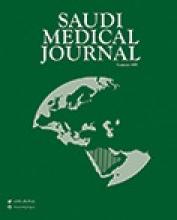Abstract
OBJECTIVE: Transradial cardiac catheterization promises fewer access site complications and improved patient comfort due to immediate ambulation. However, the use of miniaturized systems and the presence of a steep learning curve have discouraged the acceptance of transradial catheterization. The purpose of this study was to assess the applicability and learning curve of transradial catheterization in the Saudi population for operators without prior experience in this approach.
METHODS: The study was performed at the King Fahd Armed Forces Hospital, Jeddah, Kingdom of Saudi Arabia between June 2001 and January 2003. Right radial artery cannulation was performed and standard 5 French (F) femoral curve catheters for angiography and standard 6F guiding catheters were used for intervention. The first 101 patients comprised group 1 and the subsequent 101 patients comprised group 2.
RESULTS: Two hundred and two patients underwent transradial catheterization (diagnostic alone in 49%, intervention alone in 10%, and diagnostic plus intervention in 41%). The procedure was successful in 191 patients (95%). The success rate was higher (99% versus 90%, p=0.013), and the mean diagnostic catheterization time was lower (28 versus 20 minutes, p=0.013) in group 2 patients compared with group one patients. There were no vascular or ischemic complications.
CONCLUSION: Transradial catheterization is safe and feasible for diagnostic and interventional procedures. With experience, the success rates and the procedural times have both improved.
- Copyright: © Saudi Medical Journal
This is an open-access article distributed under the terms of the Creative Commons Attribution-Noncommercial-Share Alike 3.0 Unported, which permits unrestricted use, distribution, and reproduction in any medium, provided the original work is properly cited.






